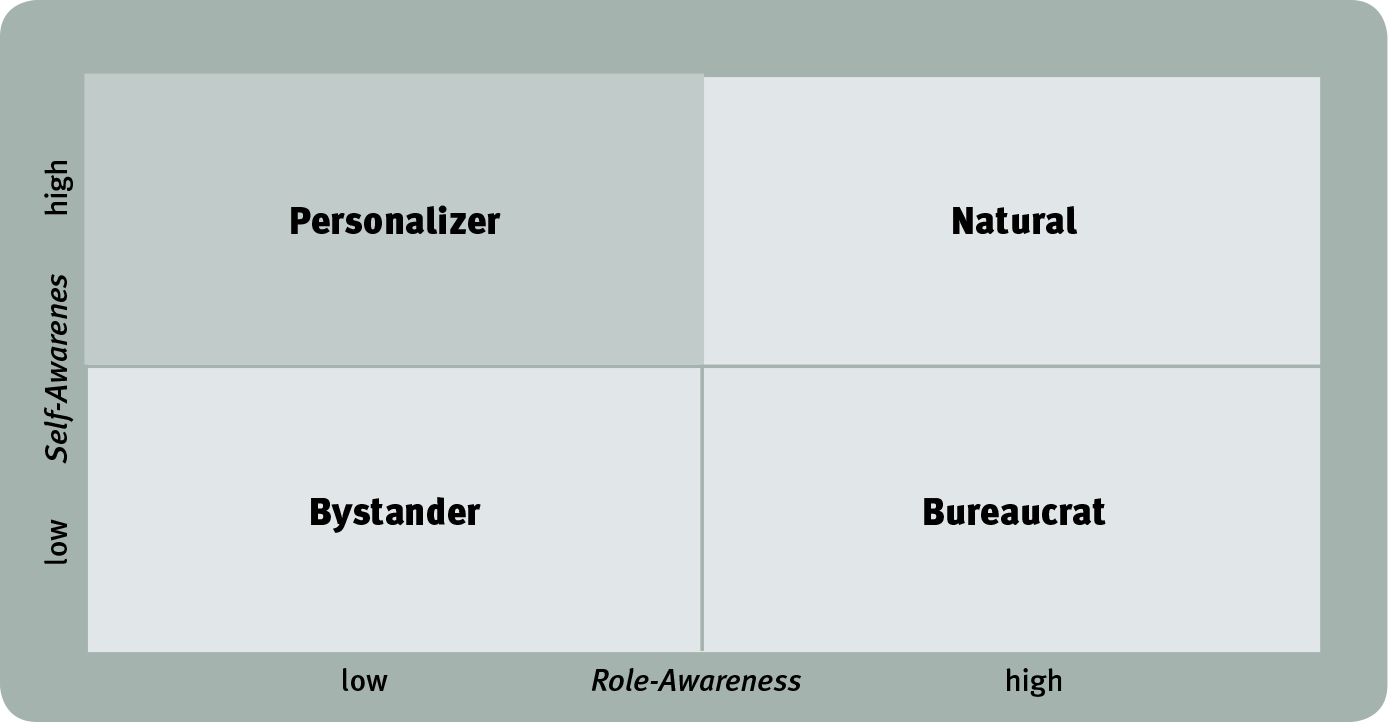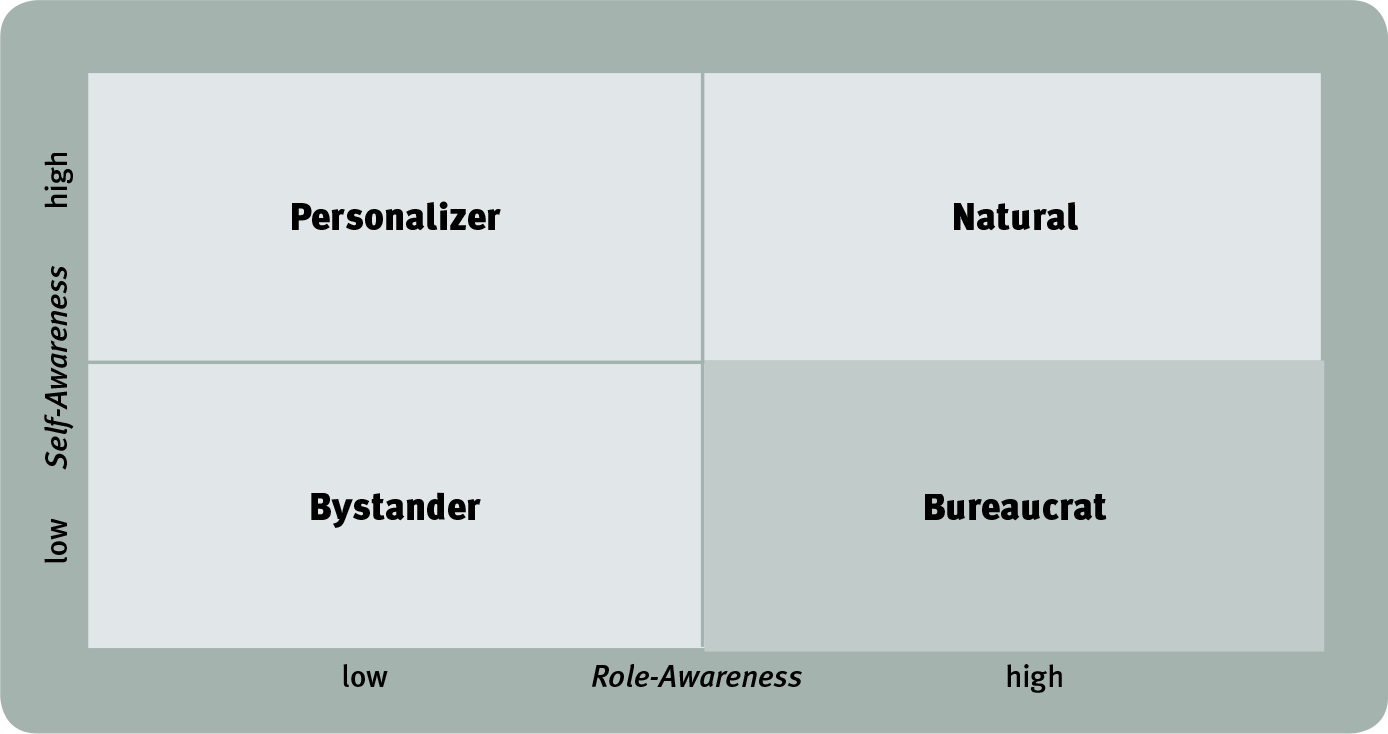Analyzing a Frustrating Incident Using the role framework tool
A grantmaker from a private foundation walked GrantCraft through a frustrating incident that arose as she introduced her foundation to a prospective grantee with a novel strategy. Reflecting back on her approach, she discovered that operating as a personalizer had ended up frustrating her, the grantseeker, and the goal at hand.
Q: In hindsight, you felt you got off track right before an important meeting between you, your boss, and two grantseekers who had an idea you really liked. What happened?
A: When the grantseekers showed up for the meeting, I really started questioning my judgment. Everything that had looked so appealing when I met them in the field seemed off. All I could think was, “What was I thinking?”
Q: What had looked so great in the field?
A: I loved their strategy. I thought they were offering fresh ideas in a field that had grown moribund. They knew business, markets, and capital strategies, and they were idealistic and progressive. They wore suits and workboots – literally and figuratively.
Q: So what was the problem in the office?
A: That they wore suits and workboots! Our office is pretty mainstream, so they looked out of place. But more important, the strategy seemed out of place, too. On the site visit, I was focused only on them. But when they came into the office, I was thinking about the rest of the foundation’s grants in this area, and I just thought, “These guys are really working at the margins of the field. Where is all this heading? How is it going to make a difference? I’m going to end up embarrassed in this meeting.” I just had a sinking feeling.
Q: In terms of the role framework, where were you operating?
A: Definitely as a personalizer. I lost touch with my role, and the fact that it was my role to support ideas and people coming from the margins of the field as well as more mainstream organizations, and got caught up in all this personal anxiety.
Q: Can you take us through the role framework, showing us what you did, and how you might have responded in a different role stance?
A: Okay. I’ll go through the four quadrants.
In all honesty, the personalizer quadrant is where I stood at the time. I should have been saying, “How can I help my foundation and the grantseeker figure out whether we could work together? What do I need to bring to the table to make that happen?” But I was really unfocused, making myself and other people anxious.
- They made some nervous comment about our fancy office, and I made a lame joke about their “cutting edge fashion.” It was friendly banter, but I’m sure it unnerved them.
- Throughout this whole process I had stopped being a bridge-builder, which was really my role. On the site visit, I had let myself totally identify with the grantees and really wasn’t thinking about where and how they would fi t with the foundation. Back in the office, I started identifying totally with the foundation. Instead of helping the grant seekers adjust to our environment, I just cringed and left them on their own. And instead of helping my boss understand where I thought the fit might be, I just sprang these people on him. It was like I was expecting each of them to do the bridge building alone – and that was my job. My boss did think, especially at first, that their idea was flaky. By losing sight of my role, I got exactly the reaction I didn’t want.
If I picture handling it like a bureaucrat, I’m leaving behind all the personal baggage that I brought to the meeting, but I’m also leaving the useful parts of my self behind, too. I’m just a grantmaker machine, instead of being myself in the grantmaker role.
- I would have duly noted that we believe in mutual learning but then not contributed to the learning myself.
- I would have kept it pretty impersonal…definitely no jokes about their clothes. But no jokes at all – no warmth or anything that might have put everyone at ease. It would have been, “We’re here to work.”
- I would have done what I often did when I was new [as a grantmaker] and not sure how to carry myself in a situation, which was to be careful not to say anything or show anything that might have been misconstrued as positive or negative feedback.
Acting as a bystander, I would have sensed from the first site visit that introducing this idea and this organization to my foundation would be tricky for me. It might be the right thing to do from a strategy point of view, but I would simply not have risen to the challenge of figuring out how to manage myself in this role.
- I don’t think there ever would have been a meeting of my boss and these grantseekers in the first place because to do that would mean accepting that my role required that. I’d just write up the proposal, point out where it differed from the foundation’s strategy, and let the board worry about it.
As a natural, instead of getting enthusiastic about their strategy and then losing sight of my role as the bridge in this learning, I would have focused much more on the learning role and what I needed to bring to the table to advance that goal.
- I would have tried to pause and get some distance from my anxiety before it undermined the mutual learning goal. I might have realized that my fixation on their clothes was related to the fact that I was worried about springing a surprise on my boss. I hadn’t given him a real read on where the organization fit politically or in terms of our other grantees.
- If I had really thought, “Look, my role here is to help my foundation explore this uncharted territory,” I might even have said that out loud! And then I might have asked my boss to come on a second site visit with me so we could both get a better chance to get to know them.
- When they came to my office, I would have picked up on how their remarks about the space were as much about their discomfort as a commentary about the foundation, and I would have tried to use humor and warmth to put them at ease so they could focus on our purpose.

